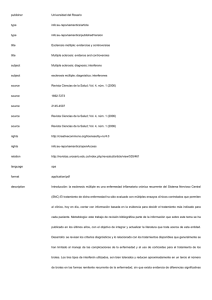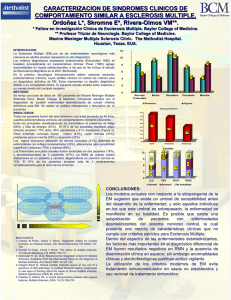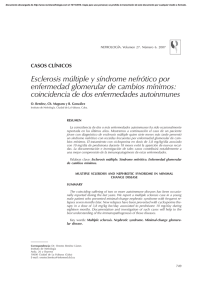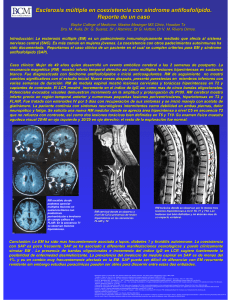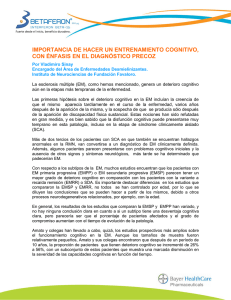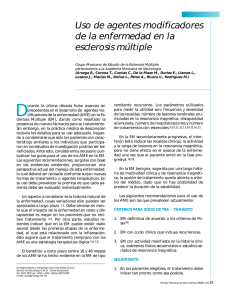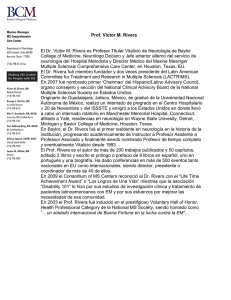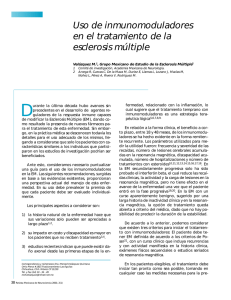Attention and control: Have we been asking the wrong questions?
Anuncio
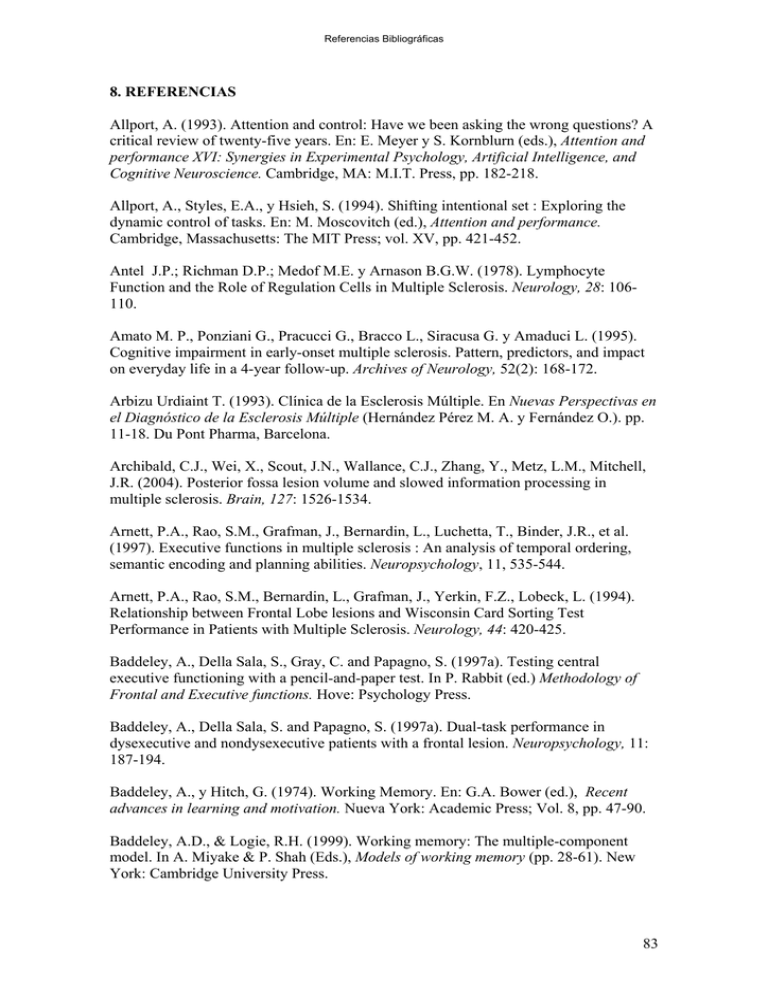
Referencias Bibliográficas 8. REFERENCIAS Allport, A. (1993). Attention and control: Have we been asking the wrong questions? A critical review of twenty-five years. En: E. Meyer y S. Kornblurn (eds.), Attention and performance XVI: Synergies in Experimental Psychology, Artificial Intelligence, and Cognitive Neuroscience. Cambridge, MA: M.I.T. Press, pp. 182-218. Allport, A., Styles, E.A., y Hsieh, S. (1994). Shifting intentional set : Exploring the dynamic control of tasks. En: M. Moscovitch (ed.), Attention and performance. Cambridge, Massachusetts: The MIT Press; vol. XV, pp. 421-452. Antel J.P.; Richman D.P.; Medof M.E. y Arnason B.G.W. (1978). Lymphocyte Function and the Role of Regulation Cells in Multiple Sclerosis. Neurology, 28: 106110. Amato M. P., Ponziani G., Pracucci G., Bracco L., Siracusa G. y Amaduci L. (1995). Cognitive impairment in early-onset multiple sclerosis. Pattern, predictors, and impact on everyday life in a 4-year follow-up. Archives of Neurology, 52(2): 168-172. Arbizu Urdiaint T. (1993). Clínica de la Esclerosis Múltiple. En Nuevas Perspectivas en el Diagnóstico de la Esclerosis Múltiple (Hernández Pérez M. A. y Fernández O.). pp. 11-18. Du Pont Pharma, Barcelona. Archibald, C.J., Wei, X., Scout, J.N., Wallance, C.J., Zhang, Y., Metz, L.M., Mitchell, J.R. (2004). Posterior fossa lesion volume and slowed information processing in multiple sclerosis. Brain, 127: 1526-1534. Arnett, P.A., Rao, S.M., Grafman, J., Bernardin, L., Luchetta, T., Binder, J.R., et al. (1997). Executive functions in multiple sclerosis : An analysis of temporal ordering, semantic encoding and planning abilities. Neuropsychology, 11, 535-544. Arnett, P.A., Rao, S.M., Bernardin, L., Grafman, J., Yerkin, F.Z., Lobeck, L. (1994). Relationship between Frontal Lobe lesions and Wisconsin Card Sorting Test Performance in Patients with Multiple Sclerosis. Neurology, 44: 420-425. Baddeley, A., Della Sala, S., Gray, C. and Papagno, S. (1997a). Testing central executive functioning with a pencil-and-paper test. In P. Rabbit (ed.) Methodology of Frontal and Executive functions. Hove: Psychology Press. Baddeley, A., Della Sala, S. and Papagno, S. (1997a). Dual-task performance in dysexecutive and nondysexecutive patients with a frontal lesion. Neuropsychology, 11: 187-194. Baddeley, A., y Hitch, G. (1974). Working Memory. En: G.A. Bower (ed.), Recent advances in learning and motivation. Nueva York: Academic Press; Vol. 8, pp. 47-90. Baddeley, A.D., & Logie, R.H. (1999). Working memory: The multiple-component model. In A. Miyake & P. Shah (Eds.), Models of working memory (pp. 28-61). New York: Cambridge University Press. 83 Referencias Bibliográficas Barak Y., y Achiron A. (2002). Effect of interferon-beta-Ib on cognitive functions in multiple sclerosis . Eur Neurol, 47: 11-14. Barroso, J., Nieto, A., Olivares, T., Wollmann, T., Hernández, M.A. (2000). Evaluación neuropsicológica en la esclerosis múltiple. Revista de Neurología, 30,(10): 985-988. Batchelor J.R., Compston D.A.S. y McDonald W.I. (1978). The Significance of the Association between HLA and Multiple Sclerosis. British Medical Bulletin, 34: 279284. Beatty WW, Goodkin DE, Hertsgaard D, Monson N. (1990). Clinical and demographic predictors of cognitive performance in multiple sclerosis. Do diagnostic type, disease duration, and disability matter?. Arch. Neurol, 47: 305-308. Beatty W.W., y Monson N. (1991). Metamemory in multiple sclerosis. Journal of clinical and experimental neuropsycology, 13(2): 309-327. Beatty WW, Monson N.(1996). Problem solving by patients with multiple sclerosis comparison of performance on the Wisconsin and California Card Sorting Tests. J Int Neuropsychol Soc. 2. 134-140. Beatty W.W., Paul R.H., Wilbanks S.L., Hames K.A., Blanco C.R. y Goodkind D.E. (1995). Identifying multiple sclerosis patients with mild or global cognitive impairment using the screening examination for cognitive impairment (SEFCI); Neurology, 45: 718-723. Benton A.L. y Hamsher K. (1976). Multilingual Aphasia Examination. Iowa city: University of Iowa. Benton A.L., Hamsher K.S., Varney N.R. y Spreen O. (1983). Contributions to Neuropsychological Assessment: a clinical manual. New York: Oxford University Press. Bezeau, S., and Graves R. (2001). Statistical Power and Effect Sizes of Clinical Neuropsychology Research. Journal of Clinical and Experimental Neuropsychology, Vol. 23, Nº 3, pp. 399-406. Bramwell B. (1903). On the relative Frecuency of Disseminated Sclerosis in this Country (Scotland and the North of England) and in America. Review of Neurology and Psychiatry, 1: 12-17. Brickenkamp, R. (1981). Test d2: Aufmerksamkeits-Belastungs-test: Handanweisung (Test d2: Concentration- Endurance- Test: Manual, 7th edn). Gottingen. Verlag fur Psychologie. Broadbent, D.E. (1958). Perception and communication. Londres: Pergamon Press. Camp, S.J., Stevenson, V.L., Thompson, A.J., Miller, D.H., Borras, C., Auriacombe, S. et al. (1999). Cognitive function in primary progressive and transitional progressive multiple sclerosis. A controlled study with MRI correlates. Brain 122: 1341-1348. 84 Referencias Bibliográficas Carlson, S., Martinkauppi, S., Rama, P., Salli, E., Korvenoja, A., and Aronen, H.J. (1998). Distribution of cortical activation during visuospatial n-back tasks as revealed by functional magnetic resonance imaging. Cerebral Cortex. Oxford University Press, Vol 8, 743-752. Caminero A. (2001). El sistema autonómico en la Esclerosis Múltiple. Cuadernos de Esclerosis Múltiple. 11; 26-37. Cohen JA, Fischer JS, Bolibrush DM, et at. (2000). Intrarater and interrater reliability of the MS Functional Composite outcome measure. Neurology, 54: 802-806. Cowan, N. (2005). Working-memory capacity limits in a theoretical context. In C. Izawa & N. Ohta (Eds.), Human learning and memory: Advances in theory and applicaton: The 4th Tsukuba International Conference on Memory. (pp. 155-175). Mahwah, NJ: Erlbaum. De Sonneville L, Boringa J, Reuling I, Lazeron R, Ader H, Polman C. (2002). Information processing characteristics in subtypes of multiple sclerosis. NeuroPsychologia, 40: 1751-1765. Delis, D.C., Kramer, J.H., Kaplan, E. Y Ober, B.a. (1987). California Verbal Learning Test. Research Edition Manual. New York: Psychological Corporation. Della Sala, S., Laiacona, M., Spinnler, H. and Ubezio, C. (1992). A cancellation test: its reliability in assessing attentional deficits in Alzheimer’s disease. Psychological Medicine, 22: 885-901. DeLuca J, Barbieri-berger S, Johnson SK. (1994). The nature of memory imparirments in multiple sclerosis: acquisition versus retrieval. J Clin Exp NeuroPsychol, 16: 18-189. DeLuca J, Chelune GJ, Tulsky DS, Lengenfelder J, Chiaravalloti ND. (2004). Is Speed Of Processing Or Working Memory The Primary Information Processing Deficit In Multiple Sclerosis?. J Clin Exp NeuroPsychol, 26: 550-562. Demarre HA, DeLuca J, Gaudino EA, Diamond BJ. ( 1999). Information processing speed- A key déficit in multiple sclerosis: implications for rehabilitation. J Neurol NeuroSurg Psychiatry, 67(5): 661-663. Dent A, Lincoln NB. (2000). Screening for memory problems in multiple sclerosis (Brief Report). Br J Clin Psychol, 39: 311-315. Detels R.;Visscher B.R.; Malmgren R.M.; Coulson A.H.; Lucia M.V. y Dudley J.P. (1977). Evidence for Lower Susceptibility to Multiple Sclerosis in JapaneseAmericans. American Journal of Epidemiology, 105. 303-310. Deutsch, J.A. y Deutsch, G. (1963). Attention : some theoretical considerations. Psychological Review,70: 80-90. 85 Referencias Bibliográficas Diller, L., Ben-Yishay, Y., and Gerstman, L.J. (1974). Studies in Cognition and Rehabilitation in Hemiplegia (Rehabilitation Monograph, N.50). New York : New York University Medical Center, Institute of Rehabilitation Medicine. Donald W., Paty, MD(1999). Técnicas de RM útiles en la Esclerosis Múltiple. The National Hospital for Neurology & Neurosurgery Queen Square. London. Ebers G.C.; Bulman D.E. y Sadovnik A.D. (1984). A Population Based Twin Study in Multiple Sclerosis. American Journal of Human Genetic, 36: 49. Eriksen, C.W. (1997). La tareas de los flancos y la competición de respuestas: Un instrumento útil para investigar una variedad de problemas cognitivos. Estudios de Psicología, 57, 93-108. Eriksen, C.W. y ST. James, J.D. (1986). Visual attention within and around the field of focal attention: A zoom lens model. Perception and Psychophysics, 40: 225-240. Fan, J.I., McCandliss, B.D., Somer, T., Raz, A., and Posner, M.I. (2002). Testing the efficieng and Independence of attentional networks. Journal of Cognitive Neuroscience, 14, 340-347. Feinstein A, Kartsounis LD, Miller DH, Youl BD, Ron MA. (1992). Clinically isolated lesions of the type seen in multiple sclerosis: a cognitive, Psychiatric, and MRI follow up study. J Neurol, Neurosurg Psychiatry, 55: 869-876. Fernández V.E. (2003). Aportación de la Neurofisiología al estudio de la Esclerosis Múltiple. Servicio de Neurofisiología Clínica. Hospital Regional Universitario Carlos Haya, Málaga, España. Fernández-Duque, D. y Posner, M.I. (1997). Relating the mechanisms of orienting and alerting. Neuropsychologia, 35: 477-486. Fernández-Duque, D. y Posner, M.I. (2001). Brain imaging of attentional networks in normal and pathological status. Journal of Clinical and Experimental Neuropsychology, 23: 74-93. Filippi M., Alberoni M., Martinelli V., Sirabian g., Bressi S., Canal N. y Comi G. (1994). Influence of clinical variables on neuropsychological performance in multiple sclerosis. European Neurology, 34: 324-328. Ficher, J.S., foley, F.W., Aikens, J.E., Ericson, G.D., Rao, S.M., & Shindell, S. (1994). What do we really know about cognitive dysfunction, affective disorders, and stress in multiple sclerosis?. A practiotioneris guide. Journal of Neurological Rehabilitation 8: 151-164. Foong J, Rosewicz L, Quaghebeur G, Davie C.A., Kartsounis LD, Thompson AJ, Miller DH and Ron MA. (1997). Executive function in multiple sclerosis. The role of frontal lobe pathology. Brain, 120: 15-26. 86 Referencias Bibliográficas García JR.; Rodríguez S.; Sosa A. M.; Batista E.; Corujo E.; Font De Mora Turón A.; Hernández D. y Betancor P. (1989). Prevalence or Multiple Sclerosis in Lanzarote (Canary Islands). Neurology, 39: 265-267. González, R., Heaton, R.K., Moore, D.J., Lentendre, S., Ellis, R.J., Wolfson, T., Marcotte, T., Cherner, M., Rippeth, J., Grant, I., & The HNRC Group. (2003). Computerized reaction time battery versus a traditional neuropsychological battery: Detecting HIV-related impaiments. Journal of the International Neuropsychological Society, 9, 64-71. González-Rosa, J.J., Vázquez-Marrufo, m., Vaquero, E., Duque, P., Borges, M., Izquierdo, G., y Gómez, c..(2005). Paradigma de Posner y Esclerosis Múltiple. 5ª Reunión Científica sobre Atención, RECA 2005, Universidad de Murcia, Murcia. Grigsby J. y Kaye K. (1994). Alphanumeric sequencing a report on a brief measure of information processing used among persons with multiple sclerosis. Perceptual and motor skills, 78: 883-887. Gronwall, D. y Sampson, H. (1974). The psychological effects of concussion. Auckland: Auckland University Press. Gronwall, D.M. (1977). Paced auditory serial-addition task. A measure of recovery from concussion: Perceptual and Motor Skills, 44: 367-373. Heaton RK, Nelson LM, Thompson DS, Burks JS, Franklin GM. (1985). NeuroPsychological findings in Relapsing/Remitting and Chronic Progressive Multiple Sclerosis. Journal of Consulting and Clinical Psychology, 53: 103-110. Hernández Pérez M.A. (1993). El dilema en el diagnóstico de la esclerosis múltiple. En: Nuevas Perspectivas en el Diagnóstico de la Esclerosis Múltiple (Hernández Pérez M.A. y Fernández O.) pp: 1-4. Du Pont Pharma, Barcelona. Honing, L.S., Ramsay, E., & Sheremata, W.A. (1992). Event-related potential P300 in multiple sclerosis: relation to magnetic resonance imaging and cognitive impairment. Archives of Neurology 49: 44-50. Hooper H.E. (1958). The Hooper Visual Organization Test Manual. Los Angeles: Western Psychological Services. James, W. (1950). The Principles of Psychology. New York, Dover Publications, Inc. (edición original de 1890). Jersild, A.T. (1927). Mental set and shift. Archives of Psychology (89). Kahneman, D. (1973). Attention and effort. Englewood Cliffs, N.J.: Prentice Hall. Klingberg, T., Foussberg, H., and Westerberg, H. (2002). Training and Working Memory. Journal of clinical and Experimental Neuropsychology, 24(69: 781-91. Klonoff H, Clark C, Oger J, et al. (1991). Neuropsychological performance in patients with mild multiple sclerosis. J Nerv Ment Dis., 179: 127-131. 87 Referencias Bibliográficas Kaplan E.F., goodglass H. y Weintraub S. (1983). The Boston naming Test. Philadelphia: Lea y Febiger. Koopmans R.A., LI D.K.B., Grochowski E., Cutler P.J. y Paty D.W. (1989). Bening versus chronic progressive multiple sclerosis: magnetic resonance imaging features. Annals of Neurology, 25: 74-81. Kujala P., Portin R., Revonsuo A. And Ruutiainen J. (1995). Attention related performance in two cognitively different subgroups of patients with multiple sclerosis. Journal of Neurology, Neurosurgery, and Psychiatry, Vol 59, 77-82. Kuroiwa Y.; Shibasaki H. y Ikeda M. (1983). Prevalence of Multiple Sclerosis and its north to south gradient in Japan. Neuroepidemiology, 2: 62-69. Kurtzke J.F. (1975). A Reassessment of the Distribution of Multiple Sclerosis. Acta Neurologica Scandinavica, 51: 110-136. Kurtzke, JF. (1983). Rating neurological impairment in multiple sclerosis: An Expanded Disability Status Scale (EDSS). Neurology, 33: 1444-1452. Kurtzke J.F. y Hyllested K. (1979). Multiple Sclerosis in the Faroe Island (I). Clinical and Epidemiological Features. Annals of Neurology, 5: 6-21. LaBerge, D. (1995). Attentional processing. London, Harvard University Press. LaBerge, D., y Brown, V. (1989). Theory of attentional operations in shape identification. Psychological Review, 96: 101-124. Lago M. y Céspedes JM. (2004). La atención y el control ejecutivo después de un traumatismo craneoencefálico. Fundación MAPFRE Medicina. Leclercq M. y Zimmermann P. (2002). Applied Neuropsychology of Attention. Theory, Diagnosis and Rehabilitation. Psychology Press. New Fetter Lane, London. Levin, H. S.; Amparo, E.; Eisenberg, H.M.; Williams, D.H.; High, W.M. Jr.; McArdle, C. B., y Weiner, R. L. (1987). Magnetic resonance imaging and computerized tomography in relation to the neurobehavioral sequelae of mild and moderate head injuries. Journal of Neurosurgery, 66: 706-713. Lezak, M.D. (1995). Neuropsychological Assessment. Nueva York: Oxford University Press. Litvan I, Grafman J, Vendrell P, Martínez JM, Junque C, Vendrell JM, BarraquerBordas L. (1988). Multiple Memory Deficits in patients with Multiple Sclerosis. Archives of Neurology, 45: 607-611. Mahler ME. (1992). Behavioral manifestations associated with multiple sclerosis. Psychiatr Clin North Am, 15(2): 427-438. 88 Referencias Bibliográficas Maurelli M., Marchioni E., Cerretano R., Bosone D., Bergamaschi R., Citterio A., Martelli A., Sibila L. y Savoldi F. (1992). Neuropsychological Assessment in MS : Clinical, Neuorphisiological and Neuroradiological Relationships. Acta neurologica Scandinavica, 86: 124-128. McDonaldd W.I. (1984). Multiple Sclerosis: Epidemiology and HLA Associations. En : Scheinberg L.; Raine C.S. eds. Multiple Sclerosis: Experimental and Clinical Aspect. New York: The New York Academy of Sciences; 109-117. McDonald W.I. (1986). The Mystery of the origin of Multiple Sclerosis. Journal of Neurology, Neurosurgery and Psychiatry, 49: 113-123. McDonald W., Compston A., Edan G., Hangtung H., Lublin F., McFarland H., Paty D., Polman C., Reingold S., Sandberg-Wolheim M., Sibley W., Thompson A. y Van Den Noorts. (2001). Recommended Diagnostic Criteria for Multiple Sclerosis. Ann Neurol. 50: 121-7. Mendozzi L, Pugnetti L, Saccani M, Motta A. (1993). Frontal lobe dysfunction in multiple sclerosis as assessed by means of lurian tasks : effect of age at onset. J Neurol Sci. 115 Suppl: S42-S50. Mesulam, M.M. (1990). Large-scale neurocognitive networks and distributed processing for attention, language, and memory. Annals of Neurology; 28: 597-613. Mesulam, M.M. (1998). From sensation to cognition. Brain; 121: 1013-1052. Miller G.A. (1956). The magical number seven, plus or minus two: some limits on our capacity for processing information. The Psychological Review, vol. 63, 81-97. Miller D.H. y Hornabrook R.W. (1984). Multiple Sclerosis in Wellington: Some Clinical and Epidemiological Features and HLA Types. Austr. NZ J.Med.; 14(3). Suppl. 1, 334. Mirsky, A.F. (1989). The neuropsychology of attention : elements of a complex behavior. En : E. Perecman (ed.), Integrating theory and practice in clinical neuropsychology. Hillsdale, N.J.: Erlbaum. Mirsky, A.F. (1996). Disorders of attention: a neuropsychological perspective. En : G.R. Lyon y N.A. Krasnegor (eds.), Attention, memory, and executive function. Baltimore: Paul H. Brookes Publishing Co. Mussini J.M. (1978). Sclérose en Plaques. Encycl. Med. Chir. (Paris). Neurologie, Fasc. 17074 B-10 (3-1978). Nieto, A., Barroso, J., Olivares, T., Wollmann, T., y Hernández, M.A. (1996). Alteraciones Neuropsicológicas en la Esclerosis Múltiple. Psicología Conductual, Vol. 4, 401-416. 89 Referencias Bibliográficas Norman, D.A., y Shallice, T. (1986). Attention to action : willed and automatic control of behavior. En: R. J. Davidson y B.J. Schwartz y D. Shapiro (eds.), Consciousness and self-regulation: Advances in research and theory. Nueva York: Plenum Press; pp. 1-18. Olivares Pérez, T. (1996). Neuropsicología de la Esclerosis Múltiple. Estudio del Patrón de Afectación en Fases Tempranas. Tesis Doctoral. Facultad de Psicología. Universidad de la Laguna. Ozonoff S and Jensen J. (1999). Brief Report: Specific executive function profiles in three neurodevelopmental disorders. Journal of Austism and Developmental Disorders; vol 29, nº2. Palffy G. (1982). Multiple Sclerosis in Hungary including the Gypsy Population. En Kuroiwa Y. y Kurland L.T. eds. Multiple Sclerosis East and West. Basel: Karger: 149157. Pashler, H. (1998). The psychology of attention. Cambridge, M.A.: MIT Press. Paty D.W., Li D.K.B., UBC MS/MRI Study Group y IFNB Multiple Sclerosis Study Group. (1993). Interferon Beta-1b is effective in relapsing-remiting multiple sclerosis . II. MRI Analysis Results of a Multicenter, Randomized, Double-Blind, PlaceboControlled Trial. Neurology, 43: 662-667. Pelosi L, Geesken JM, Holly M, et al. (1997). Working memory impairment in early multiple sclerosis. Evidence from an event-related potential study of patients with clinically isolated myelopathy. Brain, 120(part II): 2039-2058. Peyser JM, Rao SM, LaRocca NG, Kaplan E. (1990). Guidelines for NeuroPsychological Research in Multiple Sclerosis. Archives or Neurology, 47: 94-97. Plohmann, A.M., kappos, L., Ammann, W., Thordai, A., Wittwer, A., Huber, S. Bellaiche, Y., & Lechner-Scott, J. (1998). Computer assisted retraining of attentional impairments in patients with multiple sclerosis. Journal Neurol Neurosurg Psychiatry, 64, 455-462. Ponsford, J., y Kinsella, G. (1991). The use of rating scale of attentional behaviour. Neuropsychological Rehabilitation; 1: 241-257. Poser Ch.M. & Brinar, V.V. (2003). Criterios diagnósticos para la E.M.. Una revisión histórica. Cuadernos de E.M. Posner, M.I. (1980). Orienting of attention. Quarterly Journal of Experimental Psychology, 32: 3-25. Posner, M.I., Nilssen, M.J. and Ogden, W.C. (1978). Attended and unattended processing modes: the role of set for spatial location. In H.L. Pick and E. Saltzman (eds.) Modes of Perceiving and Processing of Information. Hillsdale, NJ: Lawrence Erlbaum, pp. 137-157. 90 Referencias Bibliográficas Posner, MI., y Petersen, S.E. (1990). The attention system of the human brain. Annual Review of Neuroscience, 13: 25-42. Posner, M.I., y Raichle, M.E. (1994). Images of mind. Scientific American Library. Rao, SM (2004). Cognitive function in patients with multiple sclerosis: Impairment and treatment. International Journal of MS Care, 1: 9-22. Rao SM. (1986). NeuroPsycology of Multiple Sclerosis: a critical review. Journal of Clinical and Experimental Neuropsychology, 8: 503-542. Rao SM, Grafman J, DiGiulio D, et al. (1993). Memory dysfunction in multiple sclerosis: its relation to working memory, semantic encoding, and implicit learning. Neuropsychology, 7: 364-374. Rao SM, Leo GJ, Bernardin L, unverzagt F. (1991). Cognitive dysfunction in multiple sclerosis: frequency, patterns, and prediction. Neurology, 41: 2014-2015. Rao SM, Leo GJ, Haughton VM, St Aubin-Faubert P, Bernardin L. (1989a). Correlation of magnetic resonance imaging with neuropsychological testing in multiple sclerosis. Neurology, 39: 161-166. Rao SM, Leo GJ, St. Aubin-Faubert P. (1989b). On the nature of memory disturbance in multiple sclerosis. J Clin Exp Neuropsycol, 11: 699-712. Raven JC. (1958). Advanced Progressive Matrices, Set 1. Manual. London: H.K. Lewis. Reitan RM, Reed JC, Dyken M. (1971). Cognitive, Psychomotor and Motor correlates of Multiple Sclerosis. Journal of Nervous and Mental Disease; 153: 218-224. Reitan, R.M. and Wolfson, D. (1985). The Halstead-Reitan Neuropsychological Test Battert. Tucson: Neuropsychology Press. Robertson, I.H.; Manly, T.; Beschin, n.; Daini, R.; Haeske-Dewick, H.; Homberg, V.: Jehkonen, M.; Pizzamiglio, G.; Shiel, A., y Weber, E.(1997). Auditory sustained attention is a marker of unilateral spatial neglect. Neuropsychologia, 35: 1527-1532. Robertson, I.H.; Ward, t.; Ridgeway, V., y Nimmo-Smith, I. (1994). The structure of normal human attention: The test of everyday attention. Journal of the International Neuropsychological Society, 2. Ron MA, Callanan MM, Warrington EK. (1991). Cognitive abnormalities in multiple sclerosis: a psychometric and MRI study. Psychol Med,21: 59-68. Roselló, J. (1997). Psicología de la atención: Introducción al estudio del mecanismo atencional. Madrid: Ediciones Pirámide. Rovaris M, Filippi M, Falautano M, et al. (1998). Relation between MR abnormalities and patterns of cognitive impairment in multiple sclerosis. Neurology, 50: 1601-1608. 91 Referencias Bibliográficas Ruchkin, D.S., Grafman, J., Krauss, G.L., johnson, R., Canoune, H., & Ritter, W. (1994). Event-related brain potential evidence for a verbal working memory deficit in multiple sclerosis. Brain 117: 289-305. Ruff, R.M.; Niemann, H.; Allen, C.C.; Farrow, C.E., y Wylie, T. (1992). The Ruff 2 and 7 Selective Attention Test: a neuropsychological application. Perceptual and Motor Skills, 75: 1311-1319. Sandroni, P., Walker, C., & Starr, A. (1992). Fatigue in patients with multiple sclerosis. Archives of Neurology 49: 517-524. Santiago J, Tornay F, Gómez E.(1999). Procesos psicológicos Básicos. McGrawHill Santiago J, Tornay F, Gómez E y Elosúa MR. (2006). Procesos psicológicos Básicos. McGrawHill (2ª edición). Schneider, S. (1988). Micro Experimental Laboratory: An integrated system for IBM PC compatibles. Behavior Research Methods, Instruments, & Computers, 20, 206-271. Schneider, W., Eschman, A., & Zuccolotto, A. (2002). E-Prime. User`s Guide. Psychology Software Tools, Inc... Learning research and Development Center, University of Pittsburgh. Schretlen, D., bobholz, J.H., y Brandt, J. (1996). Development and psychometric properties of the brief Test of Attention. The Clinical Neuropsychologist, 10: 80-89. Shallice T, Evans ME. (1978). The involvement of the frontal lobes in cognitive estimation. Cortex, 14: 294-303. Shapiro, K.L., & Raymond, J.E. (19949. Temporal allocation of visual attention: Inhibition or interference?. In D. Dagenbach & T.H. Carr (Eds.), Inhibitory processes in attention, memory, and language. San Diego: Academic Press. (pp. 151-188). Shaw, M., y Shaw, P. (1977). Optimal allocation of cognitive resources to spatial locations. Journal of Experimental Psychology: Human perception and performance, 3: 201-211. Shiffrin, R.M., y Schneider, W. (1977). Controlled and automatic human information precessing : 2. Perceptual learning, automatic attending and a general theory. Psychology Review; 84: 127-190. Smith, A. (1982). Symbol Digit Modalities Test (SDMT). Manual. Los Angeles: Western Psychological Services. Soelberg Sorensen MS. (2001). Enfermedad en LCR, sangre y orina en pacientes con esclerosis múltiple. Research Unit, The Neuroscience Centre, Copenhague University Hospital, Rigshospitalet, DK-2100 Sohlberg, M.M. y Mateer, C.A. (1987). Effectiveness of an attention-training program. Journal of Clinical and Experimental Neuropsychology, 9: 117-130. 92 Referencias Bibliográficas Sohlberg, M.M. y Mateer, C.A. (1989). Training use of compensatory memory books: a three stage behavioural approach. Journal of Clinical and Experimental Neuropsychology, 11: 871-891. Spielberger C., Gorsuch R., Lushene R. (1982). STAI, Manual for the State-Trait Anxiety Inventory (Self Evaluation Questionnaire). California: Consulting Psychologists Press. Adaptación española. Madrid: Sección de Estudio de Tests. TEA Ediciones S.A. Spielman R.S. y Nathason N. (1982). The Genetics of Susceptibility to Multiple Sclerosis. Epidemiology Rev., 4: 45-65. Spikman, J.M.; Deelman, B.G., y Van Zomeren, A.H. (2000). Executive functioning, attention and frontal lesions in patients with chronic CHI. Journal of Clinical and Experimental Neuropsychology, 22: 325-338. Spikman, J.M.; Kiers, H.A.; Deelman, B.G., y Van Zomeren, A.H. (2001). Construc Validity of concepts of Attention in Healthy Controls and Patients with CHI. Brain and cognition, 47: 446-460. Stablum F, Meligrana L, Sgaramella T, Bortolon F, Toso, V. (2004). Endogenous task shift processes in relapsing-remitting multiple sclerosis. Brain and Cognition, 56: 328331. Stuss, D.T., y Benson, D.F. (1986). The frontal lobes. Nueva York: Raven Press. Stroop, J.R. (1935). Studies of interference in serial verbal reactions: Journal of Experimental Psychology, 18: 643-662. Swingler RJ. y Compston D. (1986). The Distribution of Multiple Sclerosis in the United Kingdom. Journal of Neurology, Neurosurgery and Psychiatry, 49: 1115-1124. Thaugott U.; Reinherz E.C. y Raine C. (1983). Distribution of T-Cells subsets within active chronic lesions. Science, 219: 308-310. Tornay F.J. y G. Milán E. (2001). A more complete task-set reconfiguration in random than in predictable task switch. The Quarterly Journal of Experimental Psychology, 54 A (3), 785-803. Tourtellotte W.W. (1983). New Diagnostic Criteria for Multiple Sclerosis : Guidelines for Research Protocols. Annals of Neurology, 13 : 227-231. Treisman, A. y Gelade, G. (1980). A feature-integration theory of attention. Cognitive Psychology, 12: 97-136. Trenerry, M.R., Crosson, B.. DeBoe, J. and Leber, W.R. (1990). Visual Search and Attention Test. Odessa: Psychological Assessment Sources. 93 Referencias Bibliográficas Tudela, P. (1992). Atención. En J.L.F. Trespalacios y P. Tudela (eds.), Atención y Percepción, (cap.4), Madrid, Alhambra. Van Der Heijden, A.H.C. (1992). Selective Attention in Vision. New York, Routledge. Van Zomeren, A.H., y Brouwer, W.H. (1994). Clinical Neuropsychology of Attention. Nueva York: Oxford University Press. Vazquez-Marrufo, M., González—Rosa, J.J., Duque, P., Vaquero, E., Borges, M., Izquierdo, G., y Gómez, CM. (2005). Análisis electroencefalográfico del deterioro atencional en Esclerosis Múltiple. 5ª Reunión Científica sobre Atención, RECA 2005, Universidad de Murcia, Murcia. Vendrell, J.M., Renom, M., Garolea, I., González, I., Maguet, P. y Galán, I. Uso de un programa de rehabilitación cognitiva informatizada en la esclerosis múltiple. II Internacional Congreso of Neuropsychology in the Internet. Walsh M.J. y Tourtellotte W.W. (1983). The Cerebrospinal Fluid in Multiple Sclerosis. En: Hallpike J.F., Adams C.W.M. y Tourtellotte W.W. eds. Multiple Sclerosis. London: Chapman Hall: 275-358. Wechsler, D. (1987). Wechsler Memory Scale Manual. San Antonio, T.X.: The Psychological Corporation. Zakzanis, k.K. (2001). Statistics to tell the truth, the whole truth, and nothing but the truth: formulae, illustrative numerical examples, and heuristic interpretation of effect size analyses for neuropsychological researchers. Archives of Clinical Neuropsychology, 16: 653-667. Zimmermann, P. and Fimm, B. (1995). Test for Attentional Performance (TAP). English version 1.02. Herzogenrath: Psytest. 94
